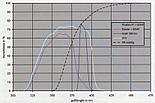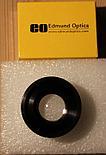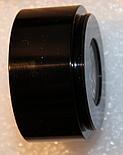Optimizing UV Venus imaging
In 2012 we will have a lot of nights with Venus visible just after sunset or before sunrise. Already a lot of Venus images have been taken. Some of them are quite spectacular as they show cloud patterns visible in the UV band. It's not easy to do any image in ultraviolet wavelengths due to many reasons - seeing affect, low camera sensitivity, UV absorption by optics. In this article I'll try to give some UV-imaging optimization tips - perfect for Venus.
UV Filters
To make a Venus image in UV we need a filter that passes only UV wavelengths. There is the new Baader U-Filter (central wavelength: 350nm, band width: 70 nm) or Astrodon UVenus (325 - 381 nm band). They are the best UV filters, but they aren't cheap as it's very hard to make such filters - that pass UV but doesn't leak infrared. From cheaper solutions you can use Schott BG39 and Wratten #47 together. Wratten #47 is a visual violet filter and BG39 is available in shops that sell industrial/scientific filters (like UQG). They must be used together to work (when combined they will pass only UV and part of the blue wavelengths with no IR leaks). Also UG-1 and BG39 make Schuler U (UV) filter. You can also combine some Hoya UV/Blue filters with BG39.
Aside of filters you will need a camera. Mono camera is required for this to work efficiently. Color Sony CCDs are nearly totally blind to UV so you won't get anything for imaging. Some color CMOS sensors may have more UV sensitivity and BG39+#47 could actually work (I've see one successful image made with a Lifecam). Among mono cameras the newest sensors with improved sensitivity are also goo for UV imaging - DMK21AU618, Point Grey Chameleon and alike. Usually it's hard to tell how much sensitivity a sensor has in UV as QE (quantum efficiency) charts start usually at 400 nm. Here is one that includes UV:

QE comparison chart
Usually you would use a Barlow lens to increase the f-ratio to the usual optimal level. UV image won't be very bright so very high resolution imaging may not be possible. The worst thing is that glass elements and their anti-reflection coatings absorb part of the ultraviolet wavelengths. Adding a Barlow may decrease the brightness even further. This is why some people use fused silica lenses as Barlows (this material doesn't absorb UV; more about it later).
For UV imaging a mirror-only telescopes are best - Newtonians, planetary Dall Kirkhams or Cassegrains. Telescopes like SCT or Maksutov will have limited UV transmission, as well as for example high spherical aberration and spherochromatism in SCTs. If you browse through Venus UV images you will notice that SCTs just can't compete with Newtonians.
UV absorption on glass elements
Most of the glass optics will be made out of a BK7 optical glass. This type of glass isn't fully transparent to UV. Within the 325 - 381 nm Astrodon UVenus band - wavelengths shorter than 350 - 360 nm will be absorbed by a noticeable degree. Also some sources (astrosystems.nl) state that anti-reflection coatings also cut UV.
Ultraviolet optics is usually made out of fused silica (or sometimes fluorite - CaF2). There aren't any fused silica Barlows on the market, but some astronomers make them on their own using lenses sold by optical companies like Edmund Optics, Thorlabs and other. SCT or Maksutov glass corrector plates, meniscus also are quite like only partially transparent to UV.
UV absorption causes the Venus UV image to be even dimmer and even harder to record. Limiting this absorption may noticeably improve the image quality.

BK7 glass transmission

Fused Silica, Spectrosil transmission

Anti-Reflection coatings transmission
If you have a SCT or a Mak you can't do anything with the glass in the telescope but still those or other telescopes like pure mirror Newtonians require a Barlow lens. The usual lenses may not be best... so few things you may do is:
- Use a fused silica lens as a Barlow
- Use a camera with very small pixels to increase resolution (like DMK72, or Point Grey Chameleon)
- If you don't have a fused silica Barlow - use a standard one with low glass thickens (2-element rather than 3-element APO or 4-element Powermate/TeleXtender)
Fused silica lenses as Barlows
To check the fused silica lenses I got a cheap double concave (DCV in short) lens from Edmund Optics. Catalog number is NT08-038 and it's available in the mega clearance category. Also Plano concave (PCV) should work - any with negative focal length (that produces diverging ray).
My lens has such parameters:- Diameter: 25,4 mm
- Effective focal length: -50 mm
- Edge thickness: 6,06 mm



Measuring UV absorption
It's hard to measure UV absorption without a lab and good tools. What I could is to compare exposure time increase of Mars (visible from my balcony) when going from f/10 (C11) to f/20 with a Meade TeleXtender or f/something with a DCV fused silica lens. When you go from f/10 to f/20 the exposure time should increase by a fixed value for every filter - channel. If UV is absorbed by the lens/TeleXtender then the exposure time increase will be bigger. The error of such measurements may be big, but still I got some rather good results.
I recorded short avis with R,G,B and UVenus filters with and without the tested lens. R,G,B were recorded at 500 gain and around 80% histogram fill. UV at max gain and around 40% histogram fill. After that I recalculated exposures for 100% histogram fill and compared with/without.
For Meade TeleXtender exposure times increased by:- Astrodon UVenus: 6,22x
- B: 3,76x
- G: 3,41x
- R: 3,90x
If the histogram fill at longer exposures is precise then the UV got noticeably dimmer than it should be. It would meant that 2x TeleXtender with 4 optical elements has only 60% efficiency in UV. That's quite low.
For DCV fused silica lens mounted closer to the camera (less than f/20) the exposure times increased as follow:- Astrodon UVenus: 2,28x
- B: 2,00x
- G: 1,96x
- R: 2,23x
So it looks like a fused silica lens really passes more UV than normal f-ratio extenders.
Comment article